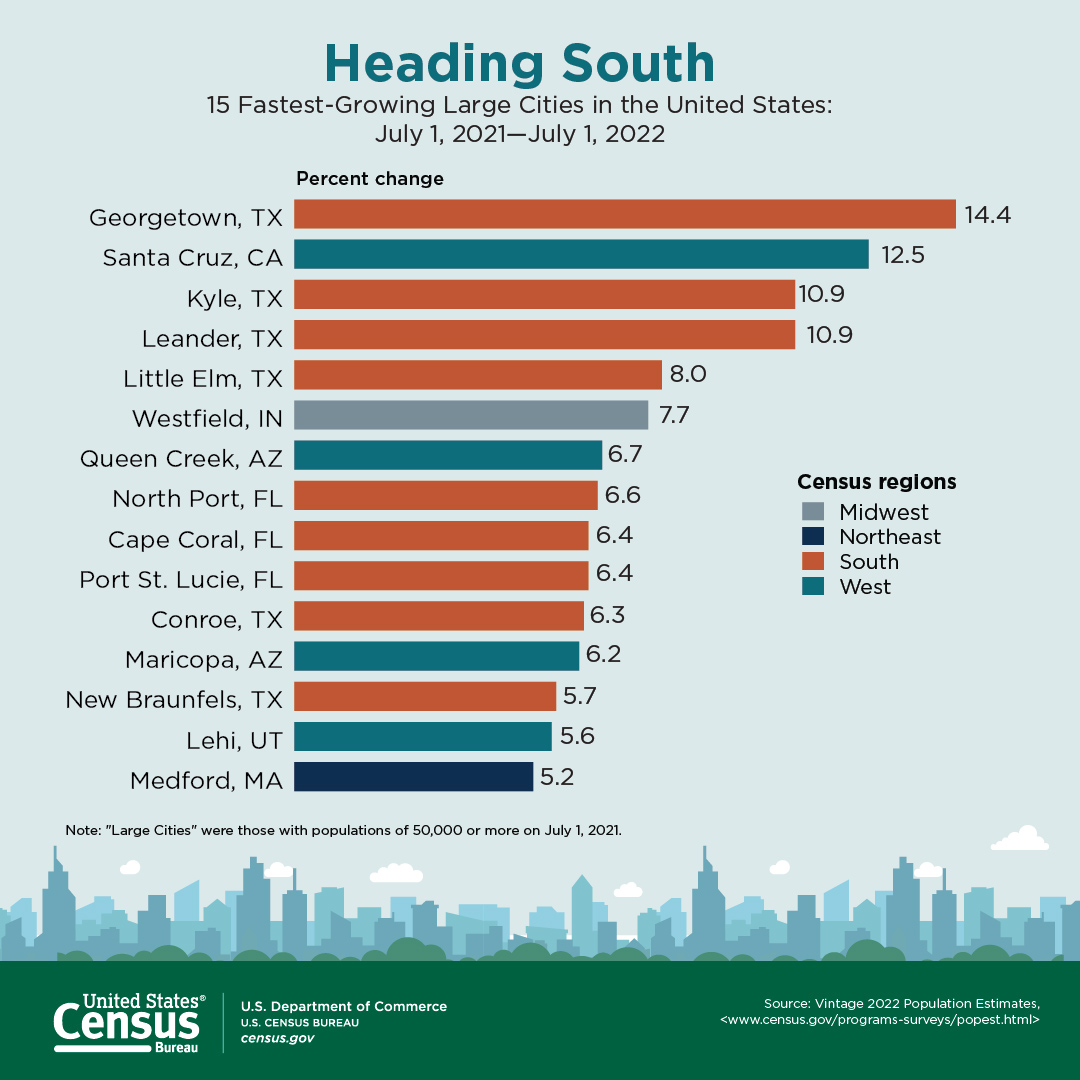Texas Continues to Top the Charts With Fastest-Growing Cities
Nine of the nation’s 15 fastest-growing cities were in the South, according to Vintage 2022 Population Estimates released today by the U.S. Census Bureau. Of the nine fastest-growing cities in the South, six were in Texas. New estimates for metropolitan and micropolitan statistical areas and for housing units at the national, state and county levels were also released today.
“Georgetown, Texas, remained the fastest-growing city by percent change in 2022, with the highest rate of growth among all U.S. cities and towns with at least 50,000 people. It wasn’t the only city to retain its distinction over the year, however,” said Crystal Delbé, a statistician in the Census Bureau’s Population Division. “New York remained the nation’s largest city, despite its recent population decline. At 8.3 million, its population was more than twice that of the next largest city, Los Angeles, with a population of nearly 4 million.”
Following the population increase of 14.4% in Georgetown, Texas, was Santa Cruz, California, with a 12.5% increase, adding roughly 7,000 people to its population. The next three fastest-growing cities were also in Texas — Kyle, Leander, and Little Elm.
Texas was the only state that had more than three cities on both the 15 fastest-growing large cities and towns by numeric change and by percent change lists. Fort Worth, Texas, had the largest numeric population gain in 2022, with an increase of 19,170 people. Phoenix, Arizona (19,053); San Antonio, Texas (18,889); Seattle, Washington (17,749); and Charlotte, North Carolina (15,217), rounded out the top five cities by numeric growth.
Most Populous Cities
Charlotte, North Carolina, returned to the list of the top 15 largest cities in 2022, ranking 15th after dropping to 16th in 2021.
Following New York and Los Angeles in population size were:
- Chicago, Illinois (2.7 million)
- Houston, Texas (2.3 million)
- Phoenix, Arizona (1.6 million)
- Philadelphia, Pennsylvania (1.6 million)
- San Antonio, Texas (1.5 million)
- San Diego, California (1.4 million)
- Dallas, Texas (1.3 million)
- Austin, Texas (1.0 million)
- Jacksonville, Florida (1.0 million)
- San Jose, California (1.0 million)
- Fort Worth, Texas (1.0 million)
- Columbus, Ohio (907,971)
Population Change in Small Towns and Regional Differences
While nearly 40% (129.6 million) of the nation’s population lived in the 4.1% (798) of cities with populations of 50,000 or more, the United States remained a nation of small towns. Of approximately 19,500 incorporated places, about 75% had fewer than 5,000 people and nearly 33% had fewer than 500.
On average, these small towns experienced uneven growth across U.S. regions:
- Northeast small towns declined by 0.4%.
- Midwest small towns declined by 0.2%.
- Small towns in the South grew by 0.4%.
- Western small towns saw the largest growth from 2021 to 2022, with an increase of 0.5%.
Other Highlights
Crossing population milestones:
- Three cities joined the list of cities with populations of 50,000 or more in 2022 — Wake Forest, North Carolina (51,113); Rockwall, Texas (51,461); and Eagle Mountain, Utah (54,149).
- Two cities in Texas crossed the 100,000 population mark in 2022 — Conroe (101,405) and New Braunfels (104,707).
Metropolitan statistical areas:
- U.S. metro areas grew by approximately 0.4% between 2021 and 2022.
- Roughly two-thirds (65.1%) of the 384 U.S. metro areas saw increases in population between 2021 and 2022.
- The New York-Newark-Jersey City, NY-NJ-PA metro area was the most populous with a population of 19,617,869 as of July 1, 2022, a decrease of 156,517 from July 1, 2021, with the Los Angeles-Long Beach-Anaheim, CA metro area being the second-most populous with a 2022 population of 12,872,322, a decrease of 100,525 from 2021.
- Ten U.S. metro areas had populations of at least 5 million in 2022, with six of the ten increasing in population between 2021 and 2022.
- The Phoenix-Mesa-Chandler, AZ metro area surpassed the 5 million population threshold between 2021 and 2022.
- The Dallas-Fort Worth-Arlington, TX metro area had the highest numeric increase in population between 2021 and 2022 of any U.S. metro area, with an annual jump of 170,396 people, followed by the Houston-The Woodlands-Sugar Land, TX metro area which added 124,281 residents over the same time period.
- The Villages, FL metro area was the fastest-growing U.S. metro area between 2021 and 2022, increasing by 7.5%.
Micropolitan statistical areas:
- U.S. micro areas grew by approximately 0.1% between 2021 and 2022.
- Approximately 45% of the 543 U.S. micro areas saw increases in population between 2021 and 2022.
- The Pullman, WA micro area had the largest numeric and percent increase of all U.S. micro areas between 2021 and 2022, adding 4,381 people (10.1%).
- The Susanville, CA micro area had the largest numeric and percent decrease of all U.S. micro areas between 2021 and 2022, declining by 1,909 people (-6.0%).
Modest Housing Unit Growth in Nearly All States
The nation’s housing stock grew by about 1.6 million units between July 2021 and July 2022, reaching a total of 143.8 million with an annual growth rate of 1.2%. This represents a slight increase from the 1.0% in 2020-2021.
- California had the largest number of housing units (14.6 million), followed by Texas (12.1 million) and Florida (10.3 million), while Wyoming (277,116) and Alaska (329,285) had the fewest housing units.
- Utah experienced the nation’s fastest growth in housing units, with an increase of 3.3% between July 1, 2021, and July 1, 2022, followed by Idaho (2.8%) and Texas (2.3%). Rhode Island (0.2%), New Jersey (0.2%), Illinois (0.2%) and Connecticut (0.3%) had the slowest rates of housing growth.
- Harris County, Texas (32,694); Maricopa County, Arizona (28,051); Travis County, Texas (27,927); Philadelphia County, Pennsylvania (24,701); and Los Angeles County, California (21,738), were the five counties with the largest numeric gains in housing units between July 1, 2021, and July 1, 2022.
- Wasatch County, Utah, was the fastest-growing county; its housing stock increased by 7.7% between July 1, 2021, and July 1, 2022, followed by Rockwall County, Texas (7.4%), and St. Johns County, Florida (6.6%). Jasper County, South Carolina, and Teton County, Idaho were tied for fourth with 6.4%.
- Bristol City, Virginia, Martinsville City, Virginia, and Grant County, Nebraska, had the largest percent decreases in housing units between 2021 and 2022 with -0.3%.






